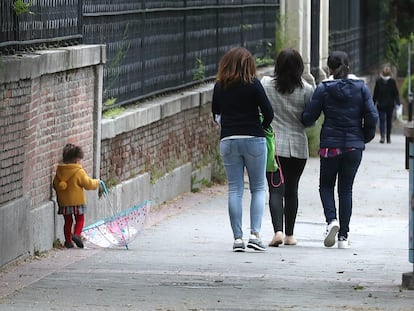Genetic analysis suggests that the coronavirus was already circulating in Spain by mid-February
A study of the first 28 genomes of the virus rules out the existence of a single ‘patient zero’ in the country

Four pages of newsprint have the same number of letters as the genetic code of the new coronavirus: 30,000. In that brief text, there is enough information to bring the whole of humanity to its knees and force billions of people to hide away in their homes. Once the virus infects a human cell, in the throat for example, the virus is capable of reproducing up to 100,000 times in just 24 hours. Each copy can contain small errors – of one letter for another – and the new viruses inherit these. The history of the pandemic can be reconstructed by studying these errors.
A team of scientists from Madrid’s Carlos III Health Institute has analyzed the first 28 genomes of the virus in Spain. The trail of the errors does not lead to a single “patient zero,” but confirms that there were a “multitude of entries” by people who had been infected in other countries during the month of February, according to the bioinformatic specialist Francisco Díez, the first signatory of the study.
Based on the information we have today, we believe that there were at least 15 different entries in SpainGeneticist Fernando González Candelas
On February 23, Fernando Simón, the director of the Health Ministry’s Coordination Center for Health Alerts, stated that “the virus is not in Spain, nor is the disease being transmitted, nor do we currently have any cases.” But it would appear that by that point the virus was already spreading unimpeded.
Díez’s team has studied the nearly 1,600 complete virus genomes read by the international scientific community up until the end of March. The analysis shows that the 28 Spanish genomes belong to the three main virus families identified in the rest of the world, which are named S, G and V.
“All of the viruses are very similar, in principle, with few mutations that differentiate them, which is good news, with all due care,” explains Díez, who is now working at the Clínic Hospital in Barcelona. The experimental vaccines that are being investigated today are being conceived for the current genetic sequence of the virus. A high rate of mutation could ruin the efficiency of the first vaccines, which are due to arrive within a year at the earliest.
The new analysis, which has been published in an open repository and has not been externally reviewed, suggests that the common ancestor of the 1,600 viruses was in the Chinese city of Wuhan around November 24. Thirteen of the Spanish genomes belong to the S family and 11 are linked to a prior case detected on February 1 in Shanghai. The first three S viruses identified in Spain are from samples taken on February 26 and 27 in Valencia. A week before, 2,500 soccer fans from the region had traveled to Milan to see Atalanta play Valencia, an event that was described as a “biological bomb” by the mayor of Bergamo, Giorgio Gori.
However, genetic analysis suggests that the coronavirus from the S family was already circulating in Spain, around February 14. Another group of half a dozen cases in Madrid suggest that the G family was already circulating in the capital around February 18.
It would appear that by February 23 the coronavirus was already spreading unimpeded in Spain
The study allows for the invisible and explosive dissemination of the virus to be seen. The case of Shanghai on February 1 is apparently related to another two samples taken in France on February 25 and 26, another in Madrid on March 2, another in Chile on March 3, another in the United States on March 4, another in Georgia on March 8 and another in Brazil on March 16. The probable transmission routes become more complicated until they form a web on the world map. Díez believes that this specific branch of the virus went from Spain to another six countries.
“There was no patient zero in Spain,” says virologist José Alcamí, who supervised the study along with his colleague, Inmaculada Casas. “There is no patient zero when an epidemic is already so widespread.” The team of geneticist Fernando González Candelas, from the Valencian foundation Fisabio, sequenced the first three Spanish genomes of the virus on March 17. His group has now read more than a hundred. “Based on the information we have today, we believe that there were at least 15 different entries in Spain. Something similar has happened in other countries, such as the US and Iceland, where multiple entries of the virus have also been identified,” González explains. “Patient zero does not exist.”
González points to the limitations of these genetic studies, which are based on the complete genomes of the virus published by the scientific community in the Gisaid open repository. There are already 11,000 complete genomes from half of the world, 150 of them from Spain. But there are essential pieces missing. “There are no relevant sequences from Italy in order to reach conclusions,” González complains. Without these genomes, possible routes of transmission from Italy to the rest of the world are invisible. What’s more, the image is always incomplete: there are 2.4 million confirmed cases on the planet, according to the latest data from the World Health Organization (WHO).
The Fisabio geneticist, who did not take part in the new study, is also optimistic on seeing the low diversity of the virus. “SARS-CoV-2 has a mutation rate that is a thousand times slower than the flu or HIV,” he says. “In principle, this is good news.”
82 days since the first case in Spain
The second case in Spain, a British citizen who became infected in the Alps, was confirmed on February 10 in Palma de Mallorca, in Spain’s Balearic Islands. Both cases were isolated and soon discharged from treatment, prompting the health authorities to believe that Spain was free of the virus by February 23.
The coronavirus, however, had already been circulating for some days, according to the genetic and epidemiological data. “No border has been able to stop the virus,” explains geneticist Fernando González Candelas, from the Fisabio foundation.
The European Center for Disease Prevention and Control warned on January 18 that Wuhan airport had six weekly direct flights to Paris, three to London and another three to Rome. That was how a multitude of “patient zeros” traveled.
English version by Simon Hunter.









































